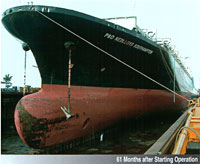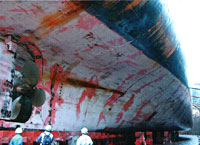Saving fuel and reducing consumption with right antifouling
Without antifouling, ships consume up to 20 percent more fuel
An important function of any antifouling coating is preventing algae, mussels, barnacles, and microorganisms from adhering to the hull. Right choice of this coating offers shipping company owners major benefits – especially when ships and boats have long lay times or are cruising on lakes and inshore water.
Panels of metal without any protective coating that were exposed to the elements in the North Sea and the Baltic Sea were covered with a growth that was several centimeters thick after only one month. Inevitably this results in marked weight gains for the ships, slower crossings, and considerably higher fuel consumption. Of course it is hard to imagine that today’s ships are operating without antifouling, but on the other hand condition of this protective coating plays key role in reducing fuel consumption on ships.
The unwanted organisms do not become attached when ships are sailing at full speed on the open sea. At the port, it’s another story, however.
Ship owners have to ask them self’s: "Where is my ship sailing? How fast will it be going? How often is it in use? When "inspection time" rolls around ?". These are all questions must be considered before making a decision which antifouling system will be used on your ship. The higher polishing rate of antifouling reduces the fuel cost but the film gets thicker and another cost will go up.
Another situation, when ships hull is being covered with microorganisms, fuel consumption is up, speed is down and planned docking interval is still many months ahead. Generally, the effect of cost reduction reveals soon after docking. We define planned docking interval as every 36 or 60 months, depending on the type of ship. By then, it’s also time to refresh the antifouling and, if needed, redo the entire finish.
Coatings for shipbuilding, renovation, and maintenance are all part of the WILCKENS portfolio

